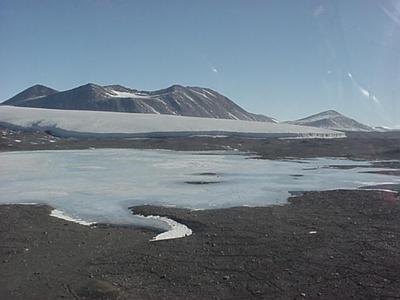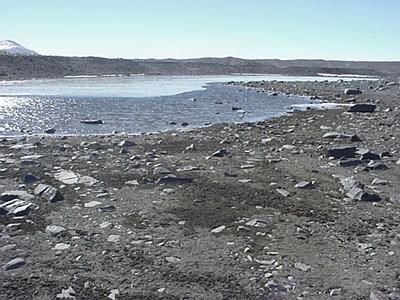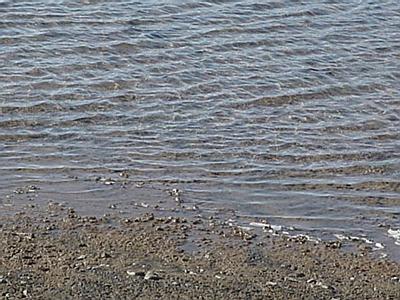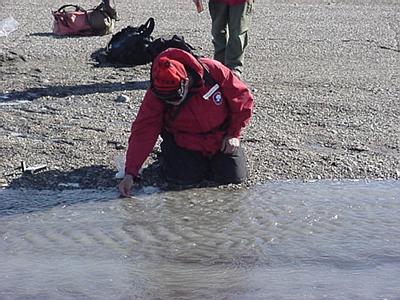10 December, 1999
Friday December 10, 1999
This will be a difficult day for it will mean saying good bye to a number of
wonderful, friendly, talented and unique people, and to say good bye to Lake
Hoare and the Taylor Valley. I woke up at 0300 hours out of a sound sleep
thinking I had over slept my flight. By the time I found my glasses and
looked at my watch, and realized I had not, I was pretty flustered.
Couldn't sleep so went through the stuff I would need at Field Site 6 (F-6)
which is located on the other side of the Canada Glacier, further down
valley and therefore closer to the Ross Sea. I feel back a sleep and woke
up about 0600 and stayed up to pack all my clothes. I am leaving the field
today.
I got to the main camp about 0645 and had a chance to chat privately with
Camp Manager Rea Spain, and 18-year veteran here on the ice. Rae does
everything and does it well. Her jobs go from ordering all supplies (Oreos
to oscillosopes);emptying and retrograding all wastes (stool to food
wastes); communication with McOps and all field parties in the valley;
flight coorinadtior for all helicopter work (Helocpoter is the only way to
get into the dry valleys) and cooking the evening meal for anywhere from 4
to 15 people. She does all this with a smile and a sense of humor, but you
do know she means business and that basically her word is law. She knows her
stuff and runs the camp with her primary concern being keeping people
healthy and safe and doing good science. It was a pleasure and an honor to
work with a woman with such outstanding abilities.
Michael Gooseff (the fellow I have been working for this week) and Ethan
Chatfield (a graduate student who like Mike is part of the "Stream Team")
showed up about 0745 and we began to bring all our supplies, and all my gear
to the staging area. The plan called for a double flight. Mike and I would
go first and then Ethan and a new hydrologist from USG named Jon Mason would
go on the second flight.
The helicopter was right on time so I said my good byes to Kathy and Rae.
We loaded the Chopper with all it could carry and we were off. It is about
a 6-minute flight up over the Canada Glacier and then down onto this broad
desert stretching probably 2 miles wide across the valley floor and at least
another 12 or so miles to the sea. Then right in front of us was Lake
Fryxell, another glacial lake much like Lake Hoare, which was showing signs
of serious melting. This lake is fed by two major glaciers the Canada and
the Commonwealth and a couple of minor ones.
On the far northern bank of the lake was Lake Fryxell Camp then off about 2
miles further down valley on the southern side I could see F-6, a wooden box
that served as a kitchen, dinning area, storage area and laboratory, and
three tents. My home for the day and Michael's, Ethan's and now Jon's home
until the end of February. (Michael has been there since October 20 and
Ethan since November 4th.)
Once we got on the ground and the copter returned with Ethan and Jon,
Michael showed Jon around. I just sat and starred at the scenery, at least
10 glaciers, some miles long, about 27 mountain peaks with an ice blue lake
to my left and a desert to my right and running out in front of me
eventually to the sea some 12 miles away. I am in total Awe!
We had a sandwich and some chocolate and some water for a snack. We then
took a couple of chocolate bars and some trail mix, we filled our water
bottles and grabbed our pea bottles and took all this stuff and put in our
backpacks. Michael and Ethan grabbed the equipment we would need today:
conductivity meter, temperature probe, a GPS meter and lots of sample
bottles. The mission was to walk out until we found Akine Stream, a stream
of Commonwealth Glacier melt water that eventually finds its way to Lake
Fryxell, and do a synoptic survey. In English that means to take GPS
positions and at that point and measure temperature, conductivity and
collect samples for cation, anion, nutrient and pH analysis.
Michael estimated that the water was probably a mile or so down valley.
Since myflight was at 1645 hours Mike decided that we should be back at F-6
by 1600 hours. It was 1100 hours when we left, that gave us about 3 hours
to find and start sampling the stream and two hours to get back to camp.
The trip out of camp down valley was amazing, it has to be what Mars is
like; sand and rocks, cold, dry as a bone with no vegetation at all. To
left and right mountains, I would guess are anywhere from 500 - 1800 meters
tall, each with glaciers running down round them on their way to the desert
floor. Some of this melt water will reach Lake Fryell, but most of it will
simply ablate into the atmosphere that has a relative humidity of around 2%
to 10%. The terrain was very difficult to travel for the sandy areas were
glacial moraine and were composed of stones and dust. The topography was a
series of little hills and valleys. As we walked I noticed a series of
"gullies", maybe 12" wide and in some cases 30' long. If you followed these
gullies out they always came in contact with two others; these seem to form
a pattern. I asked Mike what they were he told me they we frost cracks and
it is those that give the ground that sort of polygonal appearance from the
air. Wow!
The stream front was actually about 1.25 miles from camp over very difficult
terrain so by the time we got there I knew I had been doing some serious
hiking. We found the water at a spot known as Three Glacier Hole. It was
probably 20m X 30m X 8" deep. In it were great mats of algae. You could see
these in the dried up stream bed also, there they looked like greenish gray
corn-flake-like pieces of matter that were spongy not brittle in nature (We
had followed the stream bed down valley as it meandered around the ridged
landscape. We walked along the "shore" of it to prevent contaminating the
sight of future water flow be it tomorrow, next week, next month or 100
years from now. In some spots this stream bed was 10 meters wide) These
algae mats had been dry and frozen for probably at least a year in some
spots and depending of meteorological factors in the area some of the
"tributaries" of Aiken Stream may have been dry for centuries. What happens
is that the glacier in many cases miles long and wide and miles away,
therefore experiencing different weather and temperatures conditions
responds to those conditions. Sometimes this results in a lot of melt water
yet at other times very little. As this melt water moves away from the
glacier it will evaporate because of the extremely low humidity, therefore
reaching some tributaries and not others. The ceaseless wind also plays a
major role by shifting the base of the stream bed and making it easier or
harder for the water to flow in one direction or another.
We took our first samples and ran our tests at Three Glacier Hole and then
proceeded up stream taking 3 more samples over the course of the next mile
or so of stream. In some areas the stream was relatively narrow and deep,
and in some places there was a broad and beach-like with numerous rivulets,
all very shallow, bringing water to a narrower and deeper spot down stream.
We got to within, I would guess, a 1/2-mile of the glacier front, but, time
constrains made us turn around. The trip back was no prize for we followed
the stream bed back toward F-6 simply to get a second view of the area, just
in case we missed any important or interesting/significant feature on the
way out. By the time we got back to camp Ethan and I were serious-time
"bringing up the rear". That's only fair for we were the oldest and the
youngest, and that just goes with those territories.
We arrived to camp at 0355, great planning on Michael's part. We sat and
chatted for 20 minutes then I went outside to put on my ECW gear, you cannot
fly without it on, even if it is relatively warm. Once dressed I just laid
on my luggage, snuggled up in my parka, waiting for my "taxi" to arrive,
while Mike, Ethan and Jon started to run the lab tests on the samples.
Remember the kitchen/dinning room /living room, well it had to be converted
to the laboratory before any work could be done.
My chariot did not arrive until 1720 hours, you don't questions why; you
just say thanks for the "lift". It arrived in a blaze of blowing sand. The
helicopter was the big "212". It can carry up to 8 people and quite a bit
of cargo. As is always the case when the helicopter arrives you lay across
your luggage with your hood pulled completely around your face.
Barb was on board along with the pilot and helo-tech, "baggage/person
handler". I waved good bye to the guys and to the dry valley. As I did, I
knew I would never see this place again, but I also knew that I was probably
one of less then 1000 people to have ever seen this place at all. I left
with a proud, but saddened heart and with mega-tears in my eyes. No time to
be depressed though for the pilot, upon leaving F-6, flew up and over the
top of the Commonwealth Glacier. It looked like we were heading toward
Marble Point a refueling sight. We wove in an around breathtaking
mountaintops and over tremendous field of ice and snow. Finally off to the
right I could see Mt. Erebus, and I knew my guess was correct. We were
headed to Marble Point. As we came down out of the mountains a broad
glacier lead almost to the sea, ending abruptly on a spit of land that had
two small buildings and four fuel tanks. Welcome to Marble Point. We did
not refuel but picked up 3 more souls for a flight back to McTown. With
these three passengers came so much gear that the entire right rear of the
helicopter was stuffed as were the 5 passengers. In fact ,as we headed out
of Marble point over the Ross Sea the helo-tech commented to the pilot that
it had better be a quick trip (about 35 minutes) or they might have to
supply oxygen to the "sardines". Cute, but who cares, a shower and a bed
awaits me when I got back to McTown.
As we approached McTown a strange sit caught my eye. All the buildings that
made up the ice runway were lined up in single file, it looked like a circus
train. During the night and tomorrow, bulldozers would pull these
buildings, remember they are all on "skis", to thicker ice at William's
Field. Another thought, that means no more wheeled aircraft can land which
means our flight home will be a LC-1130 Hercules with skis. Significance is
that will be almost a nine hour flight as opposed to the 5 1/4 flight down
on the C-141 jet. Worry about that another day.
We touched down at 1900 hours, and by the time all the gear was offloaded
and I got to my dorm it was almost 2030 hours. A shower and to bed. It will
be great not to smell bad and to have had enough rest to realize I smelt bad
in the first place.
Good night.
Penguin Pete the Polar Man

Lake Fryxell and the Commonwealth Glacier from the Helicopter. Photo by Peter M. Amati, Jr.

Lake Fryxell and the Commonwealth glacier from in front of F-6. Photo by Peter M. Amati, Jr.

Looking down the Tayklor Valley from F-r. Photo by Peter M. Amati, Jr.

Mike Gooseff and I in the kitchen/dinning room/living room/laboratory box known as F-6. Photo by Ethan Chatfield

Weir built to measure flow in Aiken Stream. Notice the width of the stream bed (about 12-meters). Photo by Ethan Chatfield

Three Glacier Hole in the Taylor Valley. Photo by Peter M. Amati, Jr.

Alga mat covers the bottom of this small pond that is usually dry between 9 and 11 months of the year. Photo by Peter M. Amati, Jr.

Barren rock strewn desert of the Dry Valleys. Photo by Peter M. Amati, Jr.

Me doing water samples in Aiken Stream, Antarctica. Photo by Peter M. Amati, Jr.
Contact the TEA in the field at
.
If you cannot connect through your browser, copy the
TEA's e-mail address in the "To:" line of
your favorite e-mail package.
|
